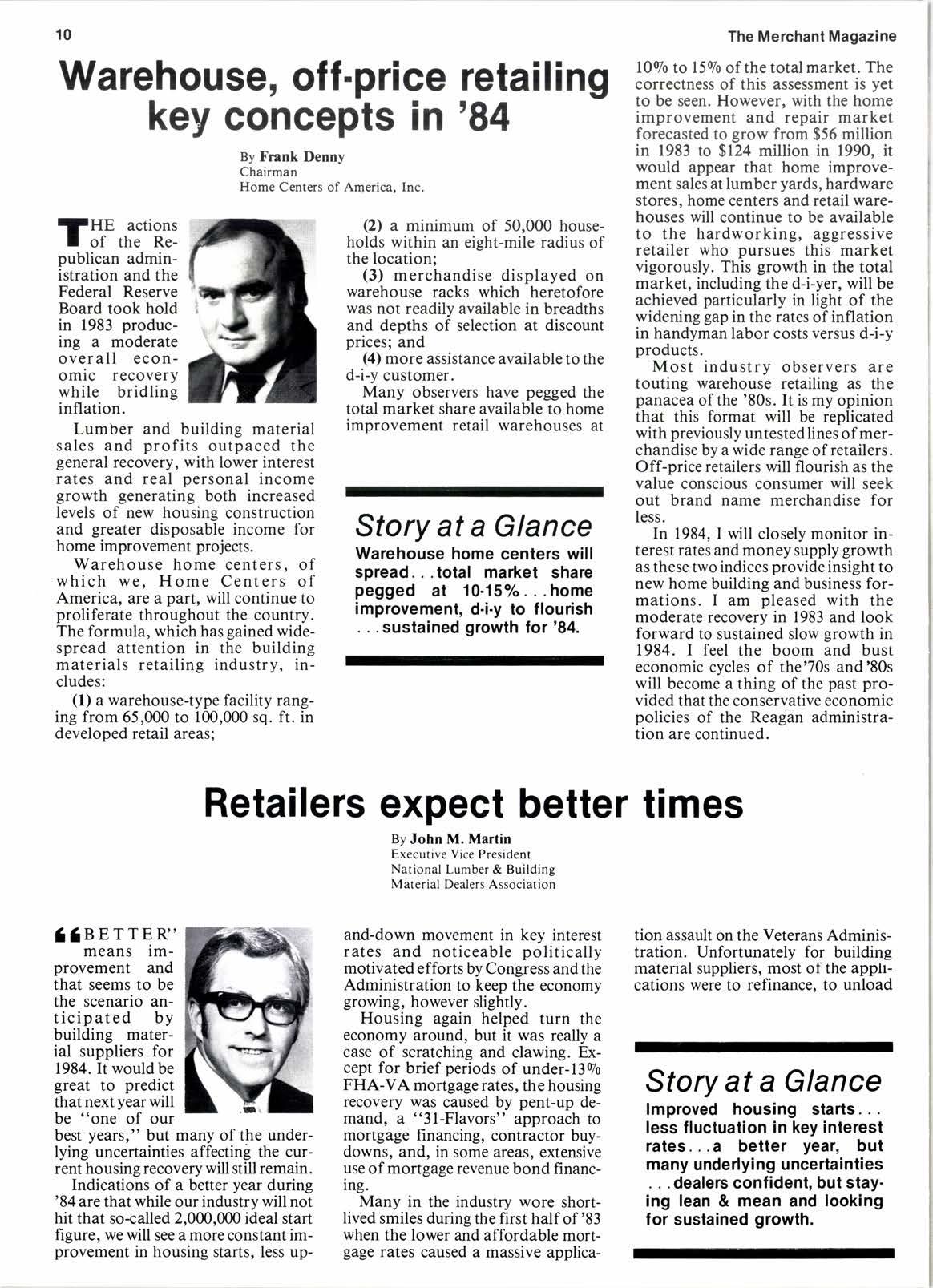
3 minute read
Warehouse, off-price retailing key concepts in '84
By Frank Denny Chairman Home Centers of America. Inc.
llHE actions
I of the Republican administration and the Federal Reserve Board took hold in 1983 producing a moderate overall economic recoverywhile bridling inflation.
Lumber and building material sales and profits outpaced the general recovery, with lower interest rates and real personal income growth generating both increased levels of new housing construction and greater disposable income for home improvement projects.
Warehouse home centers. of which we, Home Centers of America, are a part, will continue to proliferate throughout the country. The formula, which has gained widespread attention in the building materials retailing industry, includes:
(1) a warehouse-type facility ranging from 65,000 to 100,000 sq. ft. in developed retail areas;
(2) a minimum of 50,000 households within an eight-mile radius of the location;
(3) merchandise displayed on warehouse racks which heretofore was not readily available in breadths and depths of selection at discount prices; and
(4) more assistance available to the d-i-y customer.
Many observers have pegged the total market share available to home improvement retail warehouses at
Story at a Glance
Warehouse home centers will spread. .total market share pegged at 10-15o/o. .home improvement, d-i-y to flourish sustained growth for '84.
l09o to l59o of thetotalmarket. The correctness of this assessment is yet to be seen. However, with the home improvement and repair market forecasted to grow from $56 million in 1983 to $124 million in 1990, it would appear that home improvement sales at lumber yards, hardware stores, home centers and retail warehouses will continue to be available to the hardworking, aggressive retailer who pursues this market vigorously. This growth in the total market, including the d-i-yer, will be achieved particularly in light of the widening gap in the rates of inflation in handyman labor costs versus d-i-y products.
Most industry observers are touting warehouse retailing as the panacea of the '80s. It is my opinion that this format will be replicated with previously untestedlines of merchandise by a wide range of retailers. Off-price retailers will flourish as the value conscious consumer will seek out brand name merchandise for less.
In 1984, I will closely monitor interest rates and money supply growth as these two indices provide insight to new home building and business formations. I am pleased with the moderate recovery in 1983 and look forward to sustained slow growth in 1984. I feel the boom and bust economic cycles of the'70s and'80s will become a thing of the past provided that the conservative economic policies of the Reagan administration are continued.
Retailers expect better times
By John M. Martin Executive Vice President National Lumber & Building Material Dealers Association
3JBETTER' means improvement and that seems to be the scenario an- ticipated by building material suppliers for 1984. It would be great to predict that next year will be "one of our best years," but many of the underlying uncertainties affecting the current housing recovery will still remain.
Indications of a better year during '84 are that while our industry will not hit that so+alled 2,000,000 ideal start frgure, we will see a more constant improvement in housing starts, less up- and-down movement in key interest rates and noticeable politically motivated efforts by Congress and the Administration to keep the economy growing, however slightly.
Housing again helped turn the economy around, but it was really a case of scratching and clawing. Except for brief periods of under-1390 FHA-VA mortgage rates, the housing recovery was caused by pent-up demand, a "3I-Flavors" approach to mortgage financing, contractor buydowns, and, in some areas, extensive use of mortgage revenue bond financlng.
Many in the industry wore shortlived smiles during the first half of '83 when the lower and affordable mortgage rates caused a massive applica- tion assault on the Veterans Administration. Unfortunately for building material suppliers, most of the appncations were to refinance, to unload
Story at a Glance
lmproved housing starts. . less fluctuation in key interest rates...a better year, but many underlying uncertainties dealers confident, but staying lean & mean and looking for sustained growth.
the 16 and l79o mortgages that people acquired in 1981 and '82. We won't have as much of that to face in '84 so when the federal mortgage rates go down again, it should mean more new construction and resales.
Efforts to control the federal budget deficit will play a great influence on housing starts and substantial remodeling projects. Any move made by Congress and the Administration to reduce the deficit will give a psychological lift to the economy. Commerce, industry, state and local government and the buyng public just want-need-a sign that an effort is being made to restrain government's competition for capital.
Deficit reduction, coupled with the ability of major corporations to use greater than anticipated profits in 1983 to finance expansion, will lead to a more constant, reliable flow of mortgage money. As Individual Retirement Accounts (IRA's) and similar savings programs grow, and if the deficit is attacked to any degree, there will be a very noticeable relief on the existing pressure in the money markets.
Building material retailers are not unlike the Fortune 500 crowd. During the past three years or so, new markets were explored, management efficiencies became the order of the day, and personnel needs were examined more closely. The improvements have resulted in less dependence on any one segment of the buying audience, more










